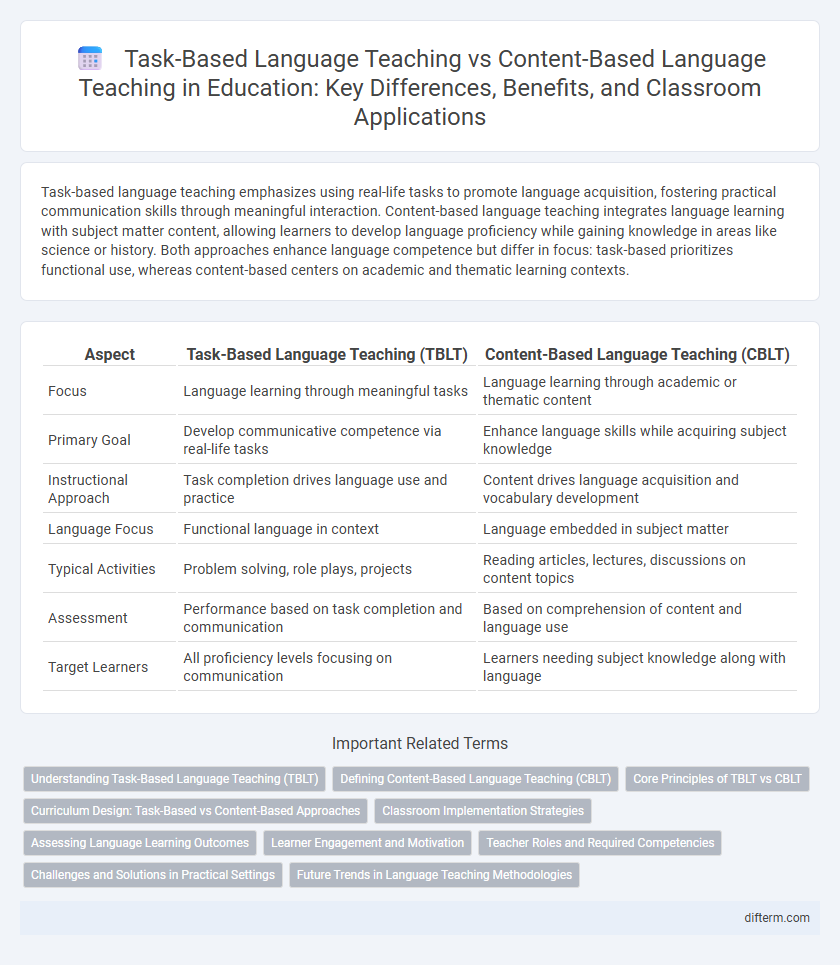Task-based language teaching emphasizes using real-life tasks to promote language acquisition, fostering practical communication skills through meaningful interaction. Content-based language teaching integrates language learning with subject matter content, allowing learners to develop language proficiency while gaining knowledge in areas like science or history. Both approaches enhance language competence but differ in focus: task-based prioritizes functional use, whereas content-based centers on academic and thematic learning contexts.
Table of Comparison
| Aspect | Task-Based Language Teaching (TBLT) | Content-Based Language Teaching (CBLT) |
|---|---|---|
| Focus | Language learning through meaningful tasks | Language learning through academic or thematic content |
| Primary Goal | Develop communicative competence via real-life tasks | Enhance language skills while acquiring subject knowledge |
| Instructional Approach | Task completion drives language use and practice | Content drives language acquisition and vocabulary development |
| Language Focus | Functional language in context | Language embedded in subject matter |
| Typical Activities | Problem solving, role plays, projects | Reading articles, lectures, discussions on content topics |
| Assessment | Performance based on task completion and communication | Based on comprehension of content and language use |
| Target Learners | All proficiency levels focusing on communication | Learners needing subject knowledge along with language |
Understanding Task-Based Language Teaching (TBLT)
Task-Based Language Teaching (TBLT) emphasizes the completion of meaningful tasks that reflect real-life language use, promoting communication and practical language skills through authentic activities. Unlike Content-Based Language Teaching (CBLT), which centers on learning language through subject matter content, TBLT focuses on using language as a tool to achieve specific outcomes, such as problem-solving or information sharing. Research shows TBLT enhances learner motivation and interaction, leading to improved fluency and language retention by engaging students in purposeful language tasks.
Defining Content-Based Language Teaching (CBLT)
Content-Based Language Teaching (CBLT) integrates language instruction with subject matter learning, emphasizing language acquisition through meaningful content. CBLT promotes authentic communication by utilizing academic subjects such as science, history, or literature as the medium for language development. This approach enhances both language proficiency and content knowledge, making learning relevant and engaging for students.
Core Principles of TBLT vs CBLT
Task-Based Language Teaching (TBLT) emphasizes authentic communication through real-world tasks, prioritizing learner interaction and practical language use over explicit grammar instruction. Content-Based Language Teaching (CBLT) integrates language learning with subject matter content, enhancing knowledge acquisition while developing language skills across disciplines. Core principles of TBLT revolve around task authenticity and learner-centeredness, whereas CBLT focuses on content integration and cognitive engagement with academic topics.
Curriculum Design: Task-Based vs Content-Based Approaches
Task-based language teaching centers curriculum design on interactive real-world tasks that promote language use through practical communication, enhancing learner engagement and contextual understanding. Content-based language teaching integrates language instruction with subject matter content, fostering language development alongside academic knowledge acquisition in disciplines like science or history. Effective curriculum design balances task complexity with content relevance to optimize language proficiency and cognitive skills simultaneously.
Classroom Implementation Strategies
Task-based language teaching (TBLT) emphasizes real-life communication tasks to promote language acquisition, integrating activities like problem-solving and role-playing that require meaningful interaction. Content-based language teaching (CBLT) centers on teaching language through subject matter, employing authentic materials and thematic lessons to build academic knowledge alongside language skills. Effective classroom implementation of TBLT and CBLT involves aligning tasks or content with learners' proficiency levels, incorporating collaborative learning, and using ongoing assessment to support language development in context.
Assessing Language Learning Outcomes
Task-based language teaching assesses language learning outcomes by focusing on learners' ability to perform real-world tasks using the target language, emphasizing practical communication skills and fluency. Content-based language teaching measures outcomes through comprehension and use of subject matter content, integrating language acquisition with academic or thematic knowledge. Both approaches utilize formative and summative assessments but differ in prioritizing task completion versus content mastery in evaluating language proficiency.
Learner Engagement and Motivation
Task-based language teaching (TBLT) enhances learner engagement by promoting real-world communication through meaningful tasks that require active problem-solving and collaboration. Content-based language teaching (CBLT) boosts motivation by integrating subject matter expertise, allowing learners to acquire language skills while exploring academic or thematic content relevant to their interests. Both approaches increase motivation and engagement differently; TBLT fosters interaction and practical use of language, whereas CBLT engages learners through cognitively challenging subject content.
Teacher Roles and Required Competencies
Task-based language teaching requires teachers to act as facilitators who design authentic, goal-oriented activities promoting real-life communication, demanding strong skills in task design, scaffolding, and formative assessment. Content-based language teaching positions teachers as subject-matter experts integrating language instruction with specific academic content, necessitating competencies in curriculum integration, content knowledge, and language support techniques. Effective implementation in both approaches depends on a teacher's ability to balance language development with learner engagement through adaptive instructional strategies.
Challenges and Solutions in Practical Settings
Task-based language teaching (TBLT) often faces challenges such as limited authentic materials and student reluctance to engage in communicative tasks, which can be mitigated by incorporating multimedia resources and scaffolding techniques to build confidence. Content-based language teaching (CBLT) struggles with balancing language objectives and subject matter complexity, resolved through careful curriculum design that integrates language support within thematic content. Both approaches benefit from ongoing teacher training and adaptive assessment methods to enhance practical implementation and learner outcomes.
Future Trends in Language Teaching Methodologies
Task-based language teaching emphasizes real-life communication through meaningful tasks, fostering learner autonomy and practical language use, while content-based language teaching integrates subject matter learning with language acquisition to enhance cognitive engagement. Future trends in language teaching methodologies point toward hybrid models that combine both approaches, leveraging digital technologies and adaptive learning to personalize instruction and promote deeper contextual understanding. Emerging AI tools and immersive virtual environments will further support dynamic, interactive tasks and content-rich simulations designed to meet diverse learner needs.
task-based language teaching vs content-based language teaching Infographic

 difterm.com
difterm.com